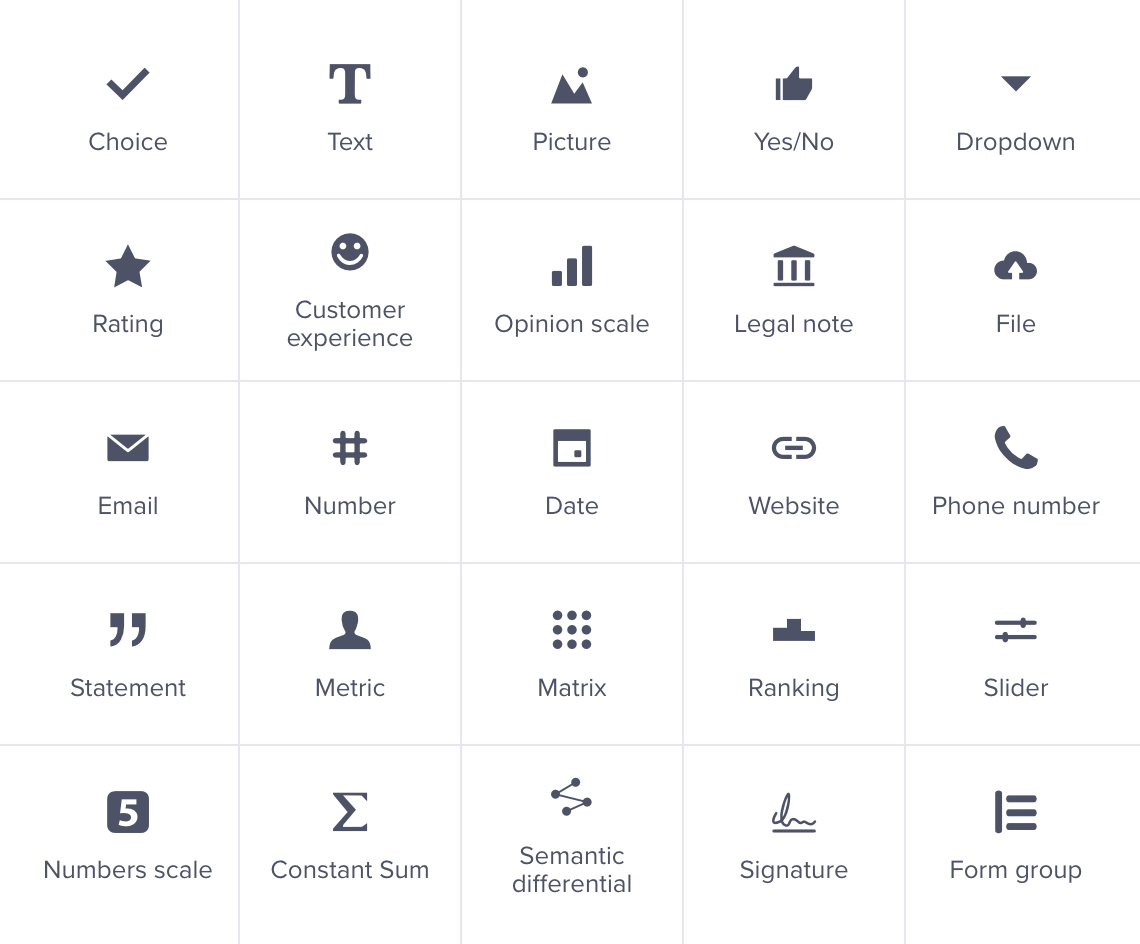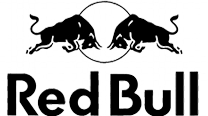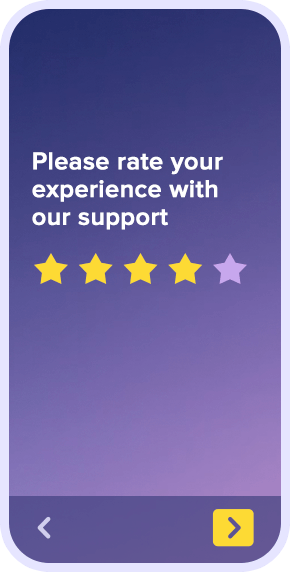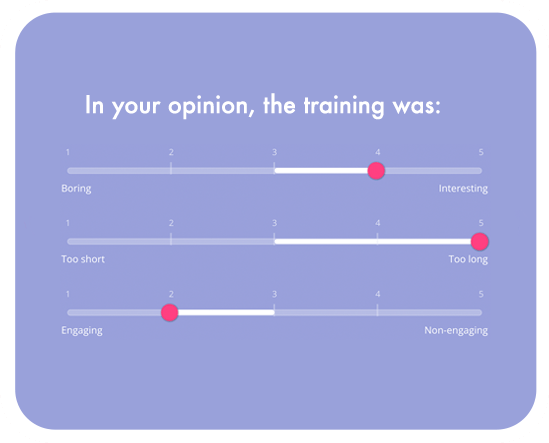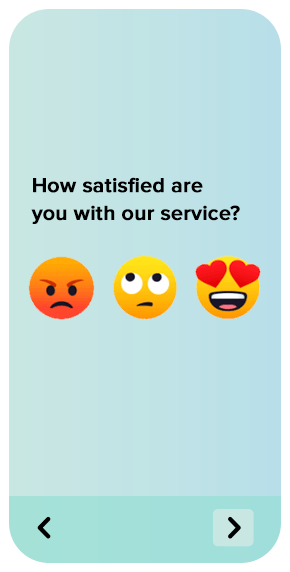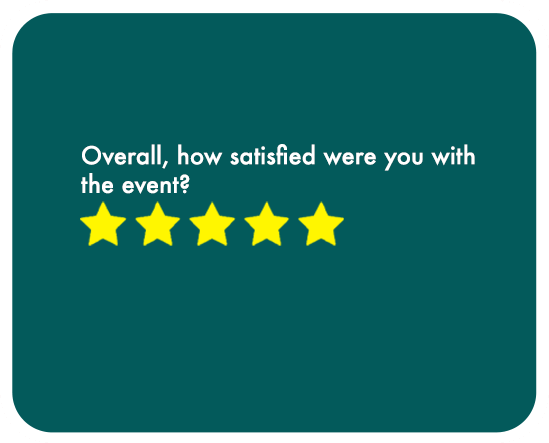Multiple Choice
Multiple Choice questions provides respondents with a list of options, and they can select single or multiple answers based on their preferences. It's also know as a Close-ended questions.
➡️ Clearly indicate to respondents that they can select multiple answers.
➡️ Consider limiting the minimum and maximum number of options that can be selected.
These questions allow respondents to provide detailed, free-form responses. They're perfect for capturing rich, qualitative insights and uncovering valuable perspectives from your audience. Example: "What features would you like to see in our upcoming product release?"
➡️ Keep the questions clear and specific to elicit relevant responses.
➡️ Avoid asking too many open-ended questions in a single survey to prevent respondent fatigue.
➡️ Analyze and categorize the responses systematically to derive meaningful conclusions.
Linkert scale
A general question is a Likert scale. It is a choice of 5 answers with one central and two extremes. We recommend our Graphical Assessment questions. Questions with answers are presented in the form of smileys and animated emoticons.
Picture Choice
Picture choice questions use visual elements or images as answer options. These are particularly useful when dealing with audiences who may have language barriers or when exploring visual preferences.
Yes/No
If you expect a yes / no answer, ask the respondent in a better way. With the Yes / No question, you can add a graphic question with icons corresponding to the Yes or No answers. This type of question is very readable for the recipient and will make your survey get more answers.
Dropdown
Presents a list of options in a dropdown menu, and respondents can select one choice from the list.
Rating
Asks respondents to rate something on a scale, usually ranging from 1 to 5 or 1 to 10. Great for Likert scale questions.
Smiley Rating
Uses smiley faces to represent different levels of satisfaction or emotions, and respondents choose the appropriate smiley.
Opinion Scale
Net Promoter Score (NPS) questions measure customer loyalty and satisfaction by asking respondents to rate their likelihood of recommending a product or service.
Legal Note
Presents respondents with a legal statement or agreement that they need to read and accept before proceeding.
File Upload
Allows respondents to upload files, such as documents, images, or videos.
Email
Asks respondents to enter their email addresses for communication or verification purposes.
Number
Requests respondents to provide a numeric value as their response.
Date
Asks respondents to select or enter a date using a date picker.
Website
Requests respondents to enter a website URL.
Phone Number
Asks respondents to enter their phone numbers for contact purposes.
Matrix
Organizes questions and options in a grid format, allowing respondents to provide multiple responses at once.
Numbers Scale
Asks respondents to rate their response using a numeric scale.
Asks respondents to rate a concept or item based on a series of bipolar adjectives or phrases.
It is used to collect information about socio-demographic characteristics. Collecting such data allows you to understand your audience better and the answers they gave. Easy to fill in the certificate is the key to the success of your research. Interests have predefined numbering questions.
Ranking
With the help of a ranking question, you can define the preferences of your survey participants by arranging specific properties in your preferred order. This order is effortless to arrange by using the drag-and-drop method, in which the selected properties are transferred to the order area with one click of the mouse. Individual properties can still be adjusted in order of precedence in the classification area. This method is easy and ergonomic to use by survey participants and thus dramatically increases the response rate. In the Analysis section, an average ranking is calculated for each answer choice, allowing you to quickly evaluate the most preferred answer choice.
Slider
Sliders are an engaging and interactive type of survey question. How it’s working? The respondent clicks a button and drags or moves it along a horizontal line, indicating his positive or negative feelings about a specific statement or question.
You can use a slider question as a more interactive alternative to the matrix table question. Instead of simply selecting a scale point, respondents drag the bar to indicate their preference level.
➡️ Use a straightforward and easy-to-understand scale. Label the endpoints of the slider clearly to indicate the minimum and maximum values.
➡️ Avoid using too many sliders in a single survey to prevent respondent fatigue.
➡️ Provide clear statements or questions that correspond to the slider's purpose. This helps respondents provide accurate and meaningful responses.
Constant Sum (Distribution of points)
The breakdown of points is handy when the respondent has to assign an appropriate value to a given question or statement. The survey owner can assign points within one scale and set the total sum of points assigned for all questions asked.
➡️ Provide clear instructions on how respondents should distribute their points.
➡️ Set a specific total sum of points for all questions to ensure a fair and consistent distribution.
➡️ Conduct a pretest to ensure that the distribution of points accurately reflects the respondents' intended preferences.
Form Group
Combines multiple related questions into a single group, often used for demographic information.
Signature
Allows respondents to provide their digital signatures as a form of agreement or verification.
